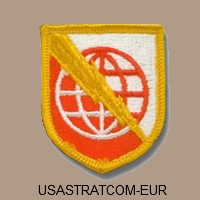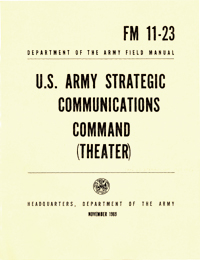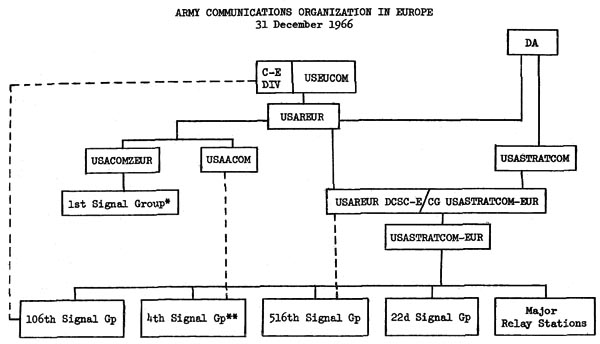 In
1947, the War Department redesignated the 9423rd TSU, War Department Signal
Center, as the U.S. Army Command and Administrative Communications Agency in
1947, simplifying the title to U.S. Army Communications Agency 10 years later.
In
1947, the War Department redesignated the 9423rd TSU, War Department Signal
Center, as the U.S. Army Command and Administrative Communications Agency in
1947, simplifying the title to U.S. Army Communications Agency 10 years later. Strategic Communication Command – Europe
-- A Brief History & The Role Of The 516th Signal Group --
 In
1947, the War Department redesignated the 9423rd TSU, War Department Signal
Center, as the U.S. Army Command and Administrative Communications Agency in
1947, simplifying the title to U.S. Army Communications Agency 10 years later.
In
1947, the War Department redesignated the 9423rd TSU, War Department Signal
Center, as the U.S. Army Command and Administrative Communications Agency in
1947, simplifying the title to U.S. Army Communications Agency 10 years later.
On April 1, 1962, ACA merged with the U.S. Army Signal Engineering Agency to form the U.S. Army Strategic Communications Command (USASCC). A staff agency of the Office of the Chief Signal Officer located in Washington, D.C., USASCC was charged with the engineering, installation, operation and maintenance of the Army’s portion of the Defense Communications Agency’s global communications network.
Even as the reorganization of the Department of Defense communications network got under way in the early 1960s, the Cuban Missile Crisis of October 1962 exposed serious flaws in communications between the U.S. State Department, American Embassies, and the Soviet Union. Post-crisis analysis of communication delays confirmed a need for a rapid upgrade of interdepartmental and international communication capabilities. President Kennedy ordered the establishment of the National Communications System interconnecting the State Department, the Department of Defense, and several other federal agencies. The Secretary of Defense became the executive agent for the NCS and the director of the Defense Communications Agency (later redesignated Defense Information Systems Agency) was appointed NCS manager.
 The
USASCC’s mission, as the Army proponent of the NSC, expanded in December 1962 to
encompass (1) the management of strategic transportable communications, fixed
signal communications, the Military Affiliate Radio System, frequency
interference resolution, and communications equipment research and development;
(2) worldwide test and evaluation, guidance on maintenance planning practices,
and development of engineering criteria for fixed plant and associated
equipment; (3) acquisition management of automatic data processing equipment –
except tactical – for Armywide application; and, (4) supervision of
transportation and traffic management of the Signal field command.
The
USASCC’s mission, as the Army proponent of the NSC, expanded in December 1962 to
encompass (1) the management of strategic transportable communications, fixed
signal communications, the Military Affiliate Radio System, frequency
interference resolution, and communications equipment research and development;
(2) worldwide test and evaluation, guidance on maintenance planning practices,
and development of engineering criteria for fixed plant and associated
equipment; (3) acquisition management of automatic data processing equipment –
except tactical – for Armywide application; and, (4) supervision of
transportation and traffic management of the Signal field command.
As USASCC’s mission grew, so too, did its physical appearance. Activation of the 11th Signal Group (later Brigade) and the 505th Signal Company May 1, 1963 at Fort Lewis, Wash., provided USASCC with tables of organization and equipment units which, when adequately trained and equipped, could support emergency operations; and emergency operations were not long in the making.
March 1, 1964, the Army established the Office of the Chief of Communications-Electronics and discontinued the Office of the Chief Signal Officer. Simultaneously, USASCC (now U.S. Army STRATCOM) became upgraded to major Army command status with full command and control over worldwide strategic communications. The organizational structure of STRATCOM quickly expanded with the establishment of STRATCOM-Europe in July 1964, STRATCOM-Pacific in September 1964 (and STRATCOM-Pacific’s STRATCOM facilities in Hawaii, Vietnam, Okinawa, Taiwan and Thailand in November 1964).
As the conflict in Southeast Asia committed more and more American forces and services, the mission of STRATCOM in Vietnam grew proportionately. Signal groups and battalions operated in the various Corps tactical zones without the benefit of centralized command and control. To fill that void, STRATCOM established the 1st Signal Brigade. Formed in 1966 in Vietnam, the 1st Signal Brigade assumed command and control over all Army communications-electronics resources in Southeast Asia. Scattered among 200 sites in Vietnam and Thailand, the brigade became the largest combat signal unit ever formed.
In 1967, STRATCOM headquarters moved from Washington, D.C., to Fort Huachuca, Ariz. In 1973, STRATCOM assumed responsibility for the communications systems at all Army posts, camps and stations, as well as depots and arsenals. This responsibility included all telephone systems, telecommunications centers, non-tactical radio systems, television distribution systems and public address systems.
As the nature of the war in Vietnam blurred the distinction between strategic and tactical communications, STRATCOM personnel and equipment became more and more supportive of tactical operations. As such, STRATCOM leaders moved to modify the command’s designation to better suit its changing mission by dropping “strategic” from its designation. In 1973, the Army redesignated STRATCOM as the U.S. Army Communications Command.
During the late 1970s and into the 1980s, the rapid proliferation of computers and ADPE throughout the Army extended the mission of USACC into information systems management. Consequently, in May 1984, USACC was redesignated U.S. Army Information Systems Command. Under the Army’s new Information Mission Area concept, USAISC began to consolidate communications with automation and other IMA disciplines to include records management, visual information, printing and publication. Before the advent of IMA, automation resource control and acquisition management was the business of individual MACOMs. Now, the Army recognized a need to centralize efforts globally under the IS management authority of USAISC.
Realignment of Communications Support
 On
1 July 1964 the Department of the Army had activated the United States Army
Strategic Communications Command as a separate major command under the Army
Chief of Staff. Concurrently, the Department had formed the United States Army
Strategic Communications Command, Europe (USASTRATCOM-EUR), as a subcommand that
was to control a substantial portion of USAREUR's communications resources,
including the 106th Signal Group—supporting USEUCOM—the 22d Signal Group, and
the major relay stations.
On
1 July 1964 the Department of the Army had activated the United States Army
Strategic Communications Command as a separate major command under the Army
Chief of Staff. Concurrently, the Department had formed the United States Army
Strategic Communications Command, Europe (USASTRATCOM-EUR), as a subcommand that
was to control a substantial portion of USAREUR's communications resources,
including the 106th Signal Group—supporting USEUCOM—the 22d Signal Group, and
the major relay stations.
After several months of experience, USAREUR had recommended improvements in the support rendered by USASTRATCOM-EUR, which were in full agreement with the unified-management principle for communications resources. In July 1965 the Department of the Army had therefore directed the further realignment of USAREUR's signal resources under USASTRATCOM-EUR, stipulating that the Commanding General of USASTRATCOM-EUR serve also as USAREUR's Deputy Chief of Stuff, Communications-Electronics (DCSC-E).
On 1 November USAREUR had transferred 17 units, including the 516th Signal Croup—supporting USAREUR headquarters—and the headquarters resources of the U.S. Army Signal Brigade, Europe, to USASTRATCOM-EUR (Chart below)
The 1966 Reorganization
In January 1966 USAREUR and USASTRATCOM conducted a joint review to determine the effectiveness of the communications support and to recommend adjustments based on the year's operating experience.
The 1965 realignment had left two of USAREUR's major commands—the United States Army Area Command (USAACOM) and the United States Army Communications Zone, Europe (USACOMZEUR)—with extensive organic communications capabilities. In April USAREUR considered the transfer of their signal support units—the 4th and 1st Signal Groups, respectively—to USASTRATCOM-EUR.
This realignment would consolidate the responsibility for operating and maintaining the Automatic Voice Switching Network (AUTOVON), Automatic Digital Network (AUTODIN), interface equipment, telephone exchanges, and communications centers. While USAACOM favored the transfer of the 4th Signal Group to USASTRATCOM-EUR, USACOMZEUR preferred to retain control of the 1st Signal Group during the critical months of the relocation from France. A realignment before completion of the relocation would complicate the difficult negotiations with the French for the continued use of the tropospheric-scatter and other long line systems.
In their second joint report, USAREUR and USASTRATCOM-EUR recommended the complete integration of the staffs of USAREUR's Communications-Electronics Division and USASTRATCOM-EUR headquarters. They also advocated the extension of the single-managership principle to include all of USAREUR's fixed-plant communications facilities. To implement this recommendation CINCUSAREUR proposed to transfer USAACOM's 4th Signal Group to USASTRATCOM-EUR by 1 October, whereas the timing of the transfer of the 1st Signal Group would depend on the problems incident to the relocation of USACOMZEUR.
USAREUR implemented the immediately feasible portion of the joint report by transferring the 4th Signal Group to USASTRATCOM-EUR on 25 August. The integration of USASTRATCOMEUR headquarters and USAREUR's Communications-Electronics Division was to await the completion of the merger of USAREUR and Seventh Army headquarters.
| UNITS ASSIGNED/ATTACHED TO STRATCOM-EUR (June 1967): | |||||||||||||||||||||||||||||||||||||||||||||||||||||||||||||||||||||||||||||||||||||||||||||||||||||||||||||||||||||||||||||||||||||||||||||||||||||||||||||||||||||||||||||||||||||||||||||||||||||||||||||||||||||||||||||||||||||||||||||||||||||||||||||||||||||||||||||||||||||||||||||||||
|
Sources:
Annual History, U.S. Army, Europe, 1 January -31 December 1966
9th Signal Command web site
USAREUR STATION LIST, 30 June 1967